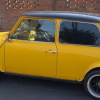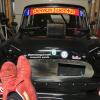Concerning 8.4" front disc set ups: I had a snapped wheel stud. Method of Replacement is not mentioned in Haynes. Various forum posts cover the topic.
There is frequent advice of the following sort:
(If it doesn't come out this way it's remove caliper, loosen four flange/disc bolts, undo castle nut, remove (disc/flange) assembly, knock out stud, tap in new stud, and rebuild, making sure you tighten the four bolts before the castle nut, and then only refit the caliper once everything else is on).
You don't need to remove the hub, tap the old stud out after removing the brakes. The new one can be fiddled into place and then pulled through using a spacer and wheel nut.
- if you can knock the remaining stud through, it might come out between the flange and the disc.
Other posters state:
The correct way to replace them (assuming here you have 8.4" Discs) is to separate the Disc from the Drive Flange. If you rotate the Disc around, there's usually one point where you'll get enough separation between the Disc and the Drive Flange to slip the new one in.
I have this to say:
The proper way was the only way for me, with 8.4" disc brakes and definatley to seperate the drive flange ffrom the Disc by removing the four nuts, after unding the hub nut. Neither The disc nor the caliper need to be removed, and may be left in position.
The flange may be taken to and held in a bench vise and the stud knocked out, (apply penetratin goil foirst and allow to saok, if in any doubt about rust) and replaced, with a little copper silp, tapping it in with a suitable puch, after aligning the splines on the stud. You will hear when the stud is sitting snug against the flange.
I could not wigggle a stud in, the new studs being flat headed. Part number is given now as NAM465 (35mm long, same as the ones they replaced).
Furthemore, as the head of the stud touches the disc boss, it will not go in straight until flange is removed, and there is great danger of misaligning the splines of the stud. I read people who coul dget the stud in but not all the way, and thus had compromised the stud hole, and cause further unnecessary work.
Perhaps the boss of the discs varies between batches, by enoug hto make a difference, but I would not bet on it.
You cannot tap the stud in with a punch if you slip it in by wiggling.. you'd have to pull it in with a nut and washer... but the stud is likely to be tipped at an angle if it doesn't slip straight in. So, dont attampt it. Perhaps it is different for 7" brakes, about which I cannot speak.
It could be possible to flatten part of the stud head, to help it slip in.. but, do you really want to do that, unless as an emergency and temporary measure.
Also, if a stud breaks, it is a sign that all all studs have been compromised by overtightening wheel nuts at some point. Therefore I replaced all four studs nicely and with ease.
The correct wheel nut torque is 40 - 44lbs/ft.
Edited by chuee, 06 September 2023 - 10:21 PM.


















